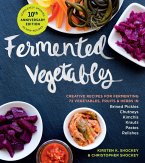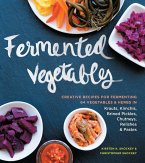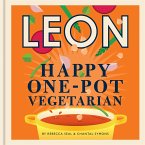Paul Barker
Naturally Fermented Bread
How to Use Yeast Water Starters to Bake Wholesome Loaves and Sweet Fermented Buns
22,99 €
inkl. MwSt.
Versandfertig in über 4 Wochen

11 °P sammeln
Paul Barker
Naturally Fermented Bread
How to Use Yeast Water Starters to Bake Wholesome Loaves and Sweet Fermented Buns
- Gebundenes Buch
- Merkliste
- Auf die Merkliste
- Bewerten Bewerten
- Teilen
- Produkt teilen
- Produkterinnerung
- Produkterinnerung
From award-winning baker Paul Barker, Naturally Fermented Bread introduces the principles of yeast-water baking, including recipes for nutritious, delicious sweet and savory bakes.
Andere Kunden interessierten sich auch für
![Tofu Tasty Tofu Tasty]() Bonnie ChungTofu Tasty14,99 €
Bonnie ChungTofu Tasty14,99 €![The Fermentation Kitchen The Fermentation Kitchen]() Sam CooperThe Fermentation Kitchen17,99 €
Sam CooperThe Fermentation Kitchen17,99 €![Happy Leons: Leon Happy Guts Happy Leons: Leon Happy Guts]() Rebecca SealHappy Leons: Leon Happy Guts17,99 €
Rebecca SealHappy Leons: Leon Happy Guts17,99 €![Fermented Vegetables, 10th Anniversary Edition Fermented Vegetables, 10th Anniversary Edition]() Christopher ShockeyFermented Vegetables, 10th Anniversary Edition28,99 €
Christopher ShockeyFermented Vegetables, 10th Anniversary Edition28,99 €![Fermented Vegetables Fermented Vegetables]() Christopher ShockeyFermented Vegetables25,99 €
Christopher ShockeyFermented Vegetables25,99 €![Happy Leons: Leon Happy One-pot Vegetarian Happy Leons: Leon Happy One-pot Vegetarian]() Rebecca SealHappy Leons: Leon Happy One-pot Vegetarian17,99 €
Rebecca SealHappy Leons: Leon Happy One-pot Vegetarian17,99 €![Good & Sweet: A New Way to Bake with Naturally Sweet Ingredients: A Baking Book Good & Sweet: A New Way to Bake with Naturally Sweet Ingredients: A Baking Book]() Brian LevyGood & Sweet: A New Way to Bake with Naturally Sweet Ingredients: A Baking Book40,99 €
Brian LevyGood & Sweet: A New Way to Bake with Naturally Sweet Ingredients: A Baking Book40,99 €-
-
-
From award-winning baker Paul Barker, Naturally Fermented Bread introduces the principles of yeast-water baking, including recipes for nutritious, delicious sweet and savory bakes.
Hinweis: Dieser Artikel kann nur an eine deutsche Lieferadresse ausgeliefert werden.
Hinweis: Dieser Artikel kann nur an eine deutsche Lieferadresse ausgeliefert werden.
Produktdetails
- Produktdetails
- Verlag: Quarry Books
- Seitenzahl: 144
- Erscheinungstermin: 13. Oktober 2020
- Englisch
- Abmessung: 223mm x 260mm x 18mm
- Gewicht: 748g
- ISBN-13: 9781631599132
- ISBN-10: 1631599135
- Artikelnr.: 58664838
- Herstellerkennzeichnung
- Libri GmbH
- Europaallee 1
- 36244 Bad Hersfeld
- gpsr@libri.de
- Verlag: Quarry Books
- Seitenzahl: 144
- Erscheinungstermin: 13. Oktober 2020
- Englisch
- Abmessung: 223mm x 260mm x 18mm
- Gewicht: 748g
- ISBN-13: 9781631599132
- ISBN-10: 1631599135
- Artikelnr.: 58664838
- Herstellerkennzeichnung
- Libri GmbH
- Europaallee 1
- 36244 Bad Hersfeld
- gpsr@libri.de
With over 35 years’ experience in his field, Paul Barker is a passionate baker with an infectious enthusiasm for his craft. Paul is a qualified baker, pâtissier, chocolatier, cake decorator, and flour miller. He has a passion for the science of baking and thrives on using this knowledge to pioneer and develop new products and approaches to baking, such as Botanical Baking. In 2005 he opened Cinnamon Square, an artisan Bakery with a Baking School for adults and children. Cinnamon Square is now a multi award–winning business. Accolades include recognition for product innovation and skills achievement from associations such as the Baking Industry, World Bread Awards, and The Great Taste Awards. His passion for science led to his first book, Cinnamon Square - A Measured Approach, a unique recipe book focused on using precision measurement and techniques to help the home baker achieve consistency and greater confidence with their baking. His second book, Naturally Fermented Bread, explores his innovative approach to baking using botanical starters. He lives in Hertfordhsire, England.
INTRODUCTION
Your Botanical Baking Journey Begins Here
1. BAKING BOTANICALLY
An Overview of the Four Key Breadmaking Methods
An Overview of Fermentation and Its Health Benefits
A Step-by-Step Guide to Starting Your Botanical Fermentation
Important Equipment for Fermenting and Baking Botanically
The Importance of Hygiene
Key Ingredients For Baking Botanically
Varieties of Breadmaking Flours
Why the Autolyse Technique Is Used in Breadmaking
Botanical Baking Allows for Experimentation
2. BREADMAKING BASICS
Recipe Advice and Structure
Keeping Time
Correct Water Temperature for Bread Dough
The Slap-and-Fold Method of Kneading
The Windowpane Test
Retarding (Overnight Refrigeration)
How to Make Your Own Proving Box
How to Test Whether a Dough Is Fully Proved
Ways to Score Dough
Advice on Gas, Electric, and Convection Ovens
How to Create Steam in the Oven
How to Bake Oven Bottom Bread
Benefits of Using a Dutch Oven
How to Control the Flavor Strength of Your Sourdough
Benefits of Milling Your Own Grains
How to Add Porridge to a Dough
How to Make Healthy Botanical Drinks
3. BOTANICAL BREADS
The Floral Loaf
Cassiobury Farm Watercress Loaf
French Baguettes
Fig and Fennel Farmhouse Loaf
Root Vegetable Foodbank Loaf
Vine-Ripened Tomato and Basil Pizza
Posh Cucumber Burger Buns
Date and Walnut Loaf
Stilton and Raisin Loaf
Kalamata Olive Ciabatta
Rosemary, Sultana, and Rock Salt Focaccia
Beet and Lemon Loaf
4. BOTANICAL SWEET BUNS
Sicilian Lemon and Raisin Belgian Buns
Award-Winning Cinnamon Square Buns
Orange, Lemon, and Currants Chelsea Buns
Strawberry and Madagascar Vanilla Swiss Finger Buns
Currants, Sultanas, Cinnamon, Clove, and Nutmeg Hot Cross Buns
Currants, Sultanas, and Earl Grey Tea Cakes
Apple and Clove Buns
Orange and Madagascar Vanilla Panettone
Chocolate Orange Brioche
Fig and Hazelnut Star
Orange, Lemon, Licorice Stick, and Strega Liqueur Savarin and Rum Baba
Award-Winning Pecan and Raisin Ricky Sticky Buns
Williams Pear and Cardamom Buns
5. SOURDOUGH BREADS
Everyday Wheat Sourdough
Award-Winning Church Street Sour
Award-Winning Wheat and Rye Sourdough
100 percent Dark Rye Sourdough Boule
Lithuanian Keptinis con Sopracciglio
APPENDIX: EDIBLE AND POISONOUS FLOWERS
Words of Warning
Edible Flowers
Poisonous Flowers
Proteolytic Enzyme-Containing Foods
Glossary
Author Bio
Acknowledgments
Index
Your Botanical Baking Journey Begins Here
1. BAKING BOTANICALLY
An Overview of the Four Key Breadmaking Methods
An Overview of Fermentation and Its Health Benefits
A Step-by-Step Guide to Starting Your Botanical Fermentation
Important Equipment for Fermenting and Baking Botanically
The Importance of Hygiene
Key Ingredients For Baking Botanically
Varieties of Breadmaking Flours
Why the Autolyse Technique Is Used in Breadmaking
Botanical Baking Allows for Experimentation
2. BREADMAKING BASICS
Recipe Advice and Structure
Keeping Time
Correct Water Temperature for Bread Dough
The Slap-and-Fold Method of Kneading
The Windowpane Test
Retarding (Overnight Refrigeration)
How to Make Your Own Proving Box
How to Test Whether a Dough Is Fully Proved
Ways to Score Dough
Advice on Gas, Electric, and Convection Ovens
How to Create Steam in the Oven
How to Bake Oven Bottom Bread
Benefits of Using a Dutch Oven
How to Control the Flavor Strength of Your Sourdough
Benefits of Milling Your Own Grains
How to Add Porridge to a Dough
How to Make Healthy Botanical Drinks
3. BOTANICAL BREADS
The Floral Loaf
Cassiobury Farm Watercress Loaf
French Baguettes
Fig and Fennel Farmhouse Loaf
Root Vegetable Foodbank Loaf
Vine-Ripened Tomato and Basil Pizza
Posh Cucumber Burger Buns
Date and Walnut Loaf
Stilton and Raisin Loaf
Kalamata Olive Ciabatta
Rosemary, Sultana, and Rock Salt Focaccia
Beet and Lemon Loaf
4. BOTANICAL SWEET BUNS
Sicilian Lemon and Raisin Belgian Buns
Award-Winning Cinnamon Square Buns
Orange, Lemon, and Currants Chelsea Buns
Strawberry and Madagascar Vanilla Swiss Finger Buns
Currants, Sultanas, Cinnamon, Clove, and Nutmeg Hot Cross Buns
Currants, Sultanas, and Earl Grey Tea Cakes
Apple and Clove Buns
Orange and Madagascar Vanilla Panettone
Chocolate Orange Brioche
Fig and Hazelnut Star
Orange, Lemon, Licorice Stick, and Strega Liqueur Savarin and Rum Baba
Award-Winning Pecan and Raisin Ricky Sticky Buns
Williams Pear and Cardamom Buns
5. SOURDOUGH BREADS
Everyday Wheat Sourdough
Award-Winning Church Street Sour
Award-Winning Wheat and Rye Sourdough
100 percent Dark Rye Sourdough Boule
Lithuanian Keptinis con Sopracciglio
APPENDIX: EDIBLE AND POISONOUS FLOWERS
Words of Warning
Edible Flowers
Poisonous Flowers
Proteolytic Enzyme-Containing Foods
Glossary
Author Bio
Acknowledgments
Index
INTRODUCTION
Your Botanical Baking Journey Begins Here
1. BAKING BOTANICALLY
An Overview of the Four Key Breadmaking Methods
An Overview of Fermentation and Its Health Benefits
A Step-by-Step Guide to Starting Your Botanical Fermentation
Important Equipment for Fermenting and Baking Botanically
The Importance of Hygiene
Key Ingredients For Baking Botanically
Varieties of Breadmaking Flours
Why the Autolyse Technique Is Used in Breadmaking
Botanical Baking Allows for Experimentation
2. BREADMAKING BASICS
Recipe Advice and Structure
Keeping Time
Correct Water Temperature for Bread Dough
The Slap-and-Fold Method of Kneading
The Windowpane Test
Retarding (Overnight Refrigeration)
How to Make Your Own Proving Box
How to Test Whether a Dough Is Fully Proved
Ways to Score Dough
Advice on Gas, Electric, and Convection Ovens
How to Create Steam in the Oven
How to Bake Oven Bottom Bread
Benefits of Using a Dutch Oven
How to Control the Flavor Strength of Your Sourdough
Benefits of Milling Your Own Grains
How to Add Porridge to a Dough
How to Make Healthy Botanical Drinks
3. BOTANICAL BREADS
The Floral Loaf
Cassiobury Farm Watercress Loaf
French Baguettes
Fig and Fennel Farmhouse Loaf
Root Vegetable Foodbank Loaf
Vine-Ripened Tomato and Basil Pizza
Posh Cucumber Burger Buns
Date and Walnut Loaf
Stilton and Raisin Loaf
Kalamata Olive Ciabatta
Rosemary, Sultana, and Rock Salt Focaccia
Beet and Lemon Loaf
4. BOTANICAL SWEET BUNS
Sicilian Lemon and Raisin Belgian Buns
Award-Winning Cinnamon Square Buns
Orange, Lemon, and Currants Chelsea Buns
Strawberry and Madagascar Vanilla Swiss Finger Buns
Currants, Sultanas, Cinnamon, Clove, and Nutmeg Hot Cross Buns
Currants, Sultanas, and Earl Grey Tea Cakes
Apple and Clove Buns
Orange and Madagascar Vanilla Panettone
Chocolate Orange Brioche
Fig and Hazelnut Star
Orange, Lemon, Licorice Stick, and Strega Liqueur Savarin and Rum Baba
Award-Winning Pecan and Raisin Ricky Sticky Buns
Williams Pear and Cardamom Buns
5. SOURDOUGH BREADS
Everyday Wheat Sourdough
Award-Winning Church Street Sour
Award-Winning Wheat and Rye Sourdough
100 percent Dark Rye Sourdough Boule
Lithuanian Keptinis con Sopracciglio
APPENDIX: EDIBLE AND POISONOUS FLOWERS
Words of Warning
Edible Flowers
Poisonous Flowers
Proteolytic Enzyme-Containing Foods
Glossary
Author Bio
Acknowledgments
Index
Your Botanical Baking Journey Begins Here
1. BAKING BOTANICALLY
An Overview of the Four Key Breadmaking Methods
An Overview of Fermentation and Its Health Benefits
A Step-by-Step Guide to Starting Your Botanical Fermentation
Important Equipment for Fermenting and Baking Botanically
The Importance of Hygiene
Key Ingredients For Baking Botanically
Varieties of Breadmaking Flours
Why the Autolyse Technique Is Used in Breadmaking
Botanical Baking Allows for Experimentation
2. BREADMAKING BASICS
Recipe Advice and Structure
Keeping Time
Correct Water Temperature for Bread Dough
The Slap-and-Fold Method of Kneading
The Windowpane Test
Retarding (Overnight Refrigeration)
How to Make Your Own Proving Box
How to Test Whether a Dough Is Fully Proved
Ways to Score Dough
Advice on Gas, Electric, and Convection Ovens
How to Create Steam in the Oven
How to Bake Oven Bottom Bread
Benefits of Using a Dutch Oven
How to Control the Flavor Strength of Your Sourdough
Benefits of Milling Your Own Grains
How to Add Porridge to a Dough
How to Make Healthy Botanical Drinks
3. BOTANICAL BREADS
The Floral Loaf
Cassiobury Farm Watercress Loaf
French Baguettes
Fig and Fennel Farmhouse Loaf
Root Vegetable Foodbank Loaf
Vine-Ripened Tomato and Basil Pizza
Posh Cucumber Burger Buns
Date and Walnut Loaf
Stilton and Raisin Loaf
Kalamata Olive Ciabatta
Rosemary, Sultana, and Rock Salt Focaccia
Beet and Lemon Loaf
4. BOTANICAL SWEET BUNS
Sicilian Lemon and Raisin Belgian Buns
Award-Winning Cinnamon Square Buns
Orange, Lemon, and Currants Chelsea Buns
Strawberry and Madagascar Vanilla Swiss Finger Buns
Currants, Sultanas, Cinnamon, Clove, and Nutmeg Hot Cross Buns
Currants, Sultanas, and Earl Grey Tea Cakes
Apple and Clove Buns
Orange and Madagascar Vanilla Panettone
Chocolate Orange Brioche
Fig and Hazelnut Star
Orange, Lemon, Licorice Stick, and Strega Liqueur Savarin and Rum Baba
Award-Winning Pecan and Raisin Ricky Sticky Buns
Williams Pear and Cardamom Buns
5. SOURDOUGH BREADS
Everyday Wheat Sourdough
Award-Winning Church Street Sour
Award-Winning Wheat and Rye Sourdough
100 percent Dark Rye Sourdough Boule
Lithuanian Keptinis con Sopracciglio
APPENDIX: EDIBLE AND POISONOUS FLOWERS
Words of Warning
Edible Flowers
Poisonous Flowers
Proteolytic Enzyme-Containing Foods
Glossary
Author Bio
Acknowledgments
Index







